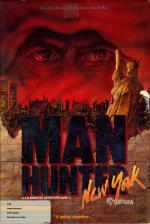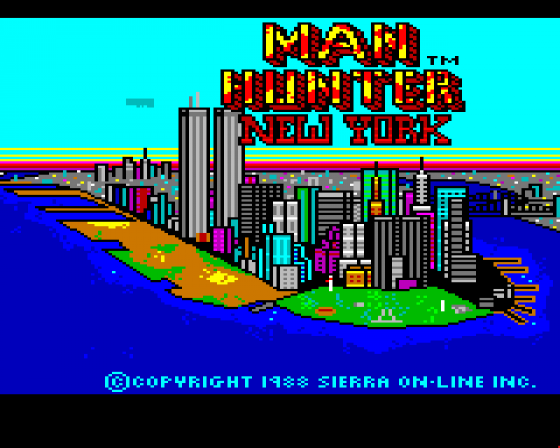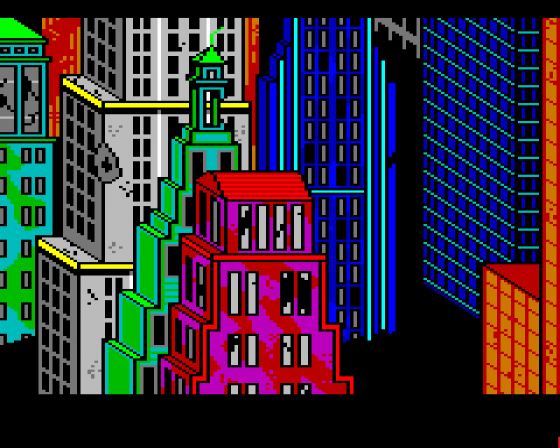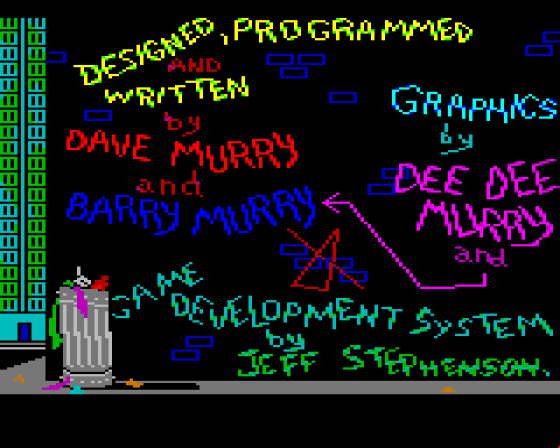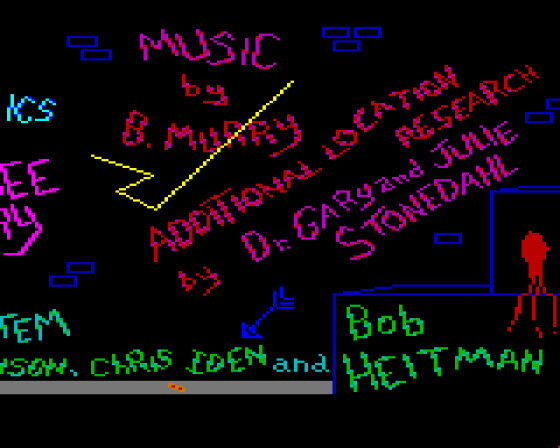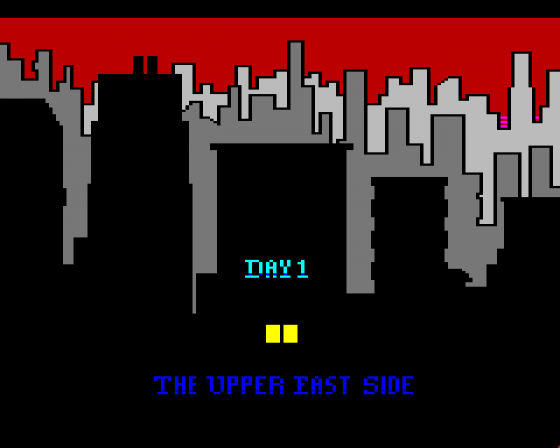
C&VG
 1st March 1989
1st March 1989
Categories: Review: Software
Publisher: Sierra
Machine: Amiga 500
Published in Computer & Video Games #89
Manhunter
It's trendy these days to predict that Adventure games will be swallowed up by RPGs - Role-Playing Games.
Well, here's a game that proves the pundits wrong! I can categorically state that the future of Adventure lies with arcade games.
The amount of text is negligible. Input is almost entirely by joystick or mouse, and output is almost entirely graphical. And yet it is a game of clever and subtle puzzles! How can that be achieved? Stay with me, and you'll find out...

An alien race called The Orbs, floating eye-like creatures, have invaded New York, and enslaved the entire population. They seem to buy working on some master plan to make changes in the atmosphere and environment. To keep humans who would sabotage their efforts out of play, they have selected a corps of elite human "Manhunters". Human activity is monitored, and when a crime against the Orbs is committed, the record of the criminal's movements just before and just after the crime, made by the Orbs' tracking system, is saved on their central computer. A Manhunter is then assigned to investigate, and run the criminal to earth.
A Manhunter's movements are restricted to places visited by the criminal, and he discovers this through using his own portable computer, nicknamed MAD (Manhunter Assignment Device), which communicates with the Orbs' mainframe. First, he displays a map of New York, and watches the criminal's movements across the city. When the target enters a building, MAD zooms in, and shows the target's movements on a detailed internal plan. When the target leaves, the tracking system zooms out, and follows him around town again to his next destination. A further refinement is the ability of the Manhunter to 'tag' any character with whom the criminal comes into contact, during the close-up tracking. Thus he can later access the tracking records for the criminal's associates.
On closing down the MAD tracking display, the Manhunter may travel to and investigate the places previously visited by the criminal, by entering "Travel" mode. Every location where the criminal stopped is highlighted with a flashing light. To travel, the Manhunter moves a marker across the map, positions it over his destination, and presses RETURN. He then moves to the location, which is shown in graphical view.
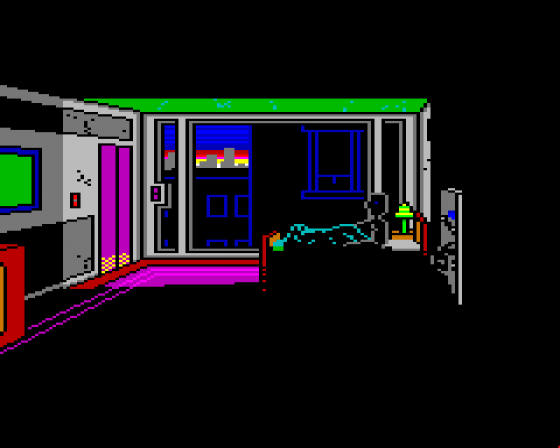
The same marker appears on this picture, and by scanning the picture with it, anything of interest or importance causes a brief message to appear at the bottom of the screen. For example, if something in the picture can be examined more closely, the marker changes to a magnifying glass when placed over it, and the message "Press Return to examine" is displayed. The marker can be moved on again without the need to press any key, and will also display, for example, each distinct exit, with an arrow indicating its direction, and a request to press RETURN to move.
This game format seems to be limited to plots with similar scenarios, but then the ability of Sierra to adapt, adopt, and improve, holds out the hope that it may well be employed for other types of stories in the future.
A slick operating system alone does not make for interesting gameplay, so what of the puzzles? They are clever and cryptic, with very few overt clues, and the player must be extra observant at all times, making deductions to be able to progress through the game.
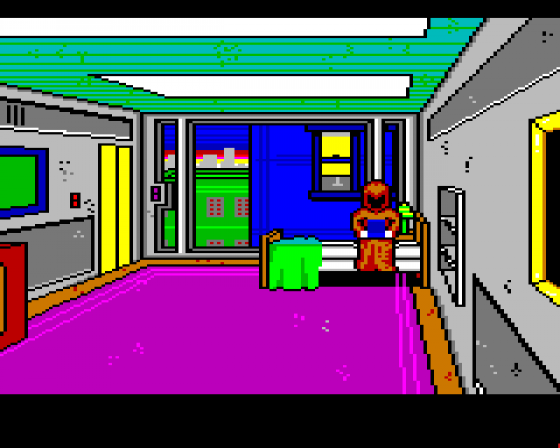
For example, the first assignment involves a visit to a bar, and a look at a video machine which the suspect was shown to be taking an interest in. The machine presents an arcade maze game, which is negotiated without touching the maze walls. Every time the player moves onto one of twelve squares containing a mat, a ball is thrown at a set of twelve kewpie dolls at the top of the screen, knocking one out. Not easy to complete, but the feeling persists that it must be played to conclusion. At the end, the player is rewarded with a picture of the funfair at Coney Island.
So why the game?
Following the suspect further, the trail ends in a ladies convenience in Central Park, where there is apparently no exit. Once that problem is solved (unlikely though the answer is!) the Manhunter finds himself in a real maze, shown in 'walk-through' mode. Some locations contain an object. Once the way to plot the maze has been established, it is only a matter of routine finding the route to the exit, and checking every cell for an object. Unless, after a short while, the player catches on that the layout of the maze is identical to the video game, and the objects in it are placed where the mats lie in the video game!

The maze leads to the real Coney Island, and here there is an apparent dead end, for the only exit is to a set of three stalls where the player is invited to test his skills at either throwing darts at balloons, balls at kewpie dolls, or hoops over bottles. The targets in all games are arranged in a four by three grid, and three missiles are offered at each attempt. I will not spoil the puzzle by telling you the answer - suffice to say that the chances of hitting the right answer accidentally are minute. The key lies in the information obtained whilst playing the video games - if you can recognise it as such!
Further arcade sequences follow in other assignments, including a real fight with a crowd of hoodlums in a back alley, dodging bottles and knives.
Manhunter is a game that grows on you the more you play it.
I started off distinctly cool, if not bored and frustrated by it. Having persevered with it, I am currently impressed and intrigued by its puzzles, and even becoming a bit nonchalant as I breeze through the occasional arcade section. In fact, I am so taken with it that I am determined to see it through to the end. And that says a lot for a game that is about as far removed from a traditional text adventure as Eugene Lacey is from solving one!
Manhunter is a big game that comes on five disks for the ST - and there are thirteen for the PC version! Therefore, it is expensive. But if you like the sound of it, and can afford the price, I urge you to rush out and buy one!
Scores
Amiga 500 Version| Graphics | 81% |
| Playability | 92% |
| Puzzleability | 93% |
| Atmosphere | 82% |
| Personal | 93% |
| Value For Money | 88% |
| Overall | 88% |
Scores
PC (MS-DOS) Version| Graphics | 81% |
| Playability | 92% |
| Puzzleability | 93% |
| Atmosphere | 82% |
| Personal | 93% |
| Value For Money | 88% |
| Overall | 88% |
Scores
Atari ST Version| Graphics | 81% |
| Playability | 92% |
| Puzzleability | 93% |
| Atmosphere | 82% |
| Personal | 93% |
| Value For Money | 88% |
| Overall | 88% |

